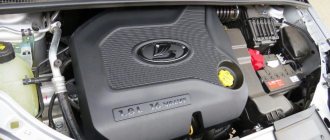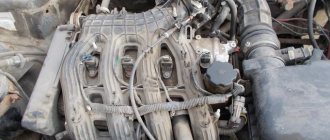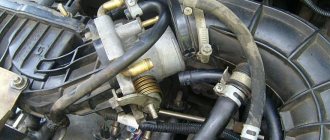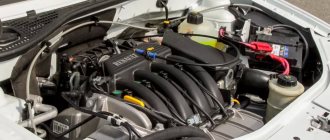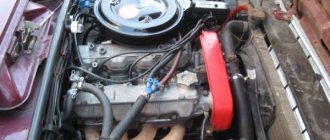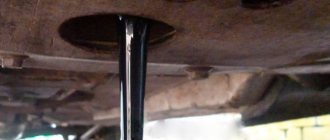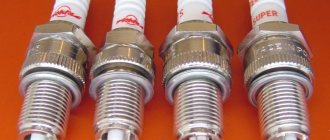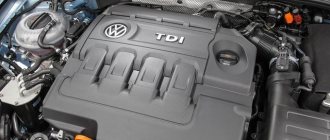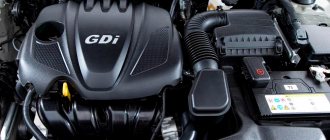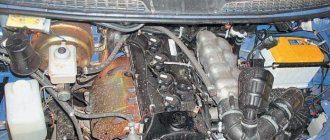Technical characteristics of VAZ engines
The technical characteristics of VAZ Classic engines are quite simple. During the production of the first engine, the engines were improved and the VAZ 2106 and 2107 engines are considered to be the best representatives.
Before we begin describing maintenance and repair, it is worth understanding which VAZ engines were installed on the “Classic”:
Lada 2101 "Kopeyka"
We can say that this is the most legendary car produced by AvtoVAZ. To this day, this vehicle and power unit can be found throughout the CIS and beyond.
VAZ 2101
| Name | Characteristic |
| Brand | 2101 |
| Marking | 1.2 l (1198 cm3) |
| Power | 64 hp |
| Type | Carburetor |
| Fuel | Petrol |
| Valve mechanism | 8 valve |
| Number of cylinders | 4 |
| Fuel consumption | 9.2 liters |
| Piston diameter | 76 mm |
| Resource | 120 - 150 thousand km |
VAZ 21011
| Name | Characteristic |
| Brand | 2101 |
| Marking | 1.3 l (1294 cm3) |
| Power | 69 hp |
| Type | Carburetor |
| Fuel | Petrol |
| Valve mechanism | 8 valve |
| Number of cylinders | 4 |
| Fuel consumption | 9.5 liters |
| Piston diameter | 79 mm |
| Resource | 120 - 150 thousand km |
All power units were equipped with a 4-speed gearbox. Also, the VAZ 2101 engine was installed on the Lada 2102. The successor to the power unit was the engine marked 2103.
VAZ 2103
Vehicles marked LADA 2103 were equipped with engines 2101, 21011 and the new VAZ 2103 engine.
| Name | Characteristic |
| Brand | 2103 |
| Marking | 1.5 l (1452 cm cube) |
| Power | 71 hp |
| Type | Carburetor |
| Fuel | Petrol |
| Valve mechanism | 8 valve |
| Number of cylinders | 4 |
| Fuel consumption | 8.5 liters |
| Piston diameter | 76 mm |
| VAZ engine life | 120 - 150 thousand km |
Like previous power units, the 2103 had a 4-speed gearbox. Cooling was liquid, forced, with a constantly running cooling fan.
VAZ 2104
The “Four” was produced for quite a long time, so its board received all possible engines and their modifications. Thus, VAZ engines of the following markings were mounted on the 2104: 2103, 2105, 21067, 21073 and 341. Let’s look at the characteristics in more detail:
Motor VAZ 2105
| Name | Characteristic |
| Brand | 2105 |
| Marking | 1.3 l (1290 cm3) |
| Power | 46 kW |
| Type | Carburetor |
| Fuel | Petrol |
| Valve mechanism | 8 valve |
| Number of cylinders | 4 |
| Fuel consumption | 10 liters |
| Piston diameter | 76 mm |
| VAZ engine life | 120 - 150 thousand km |
VAZ 21067
| Name | Characteristic |
| Brand | 21067 |
| Marking | 1.6 l (1569 cm3) |
| Power | 82 hp |
| Type | Injector |
| Fuel | Petrol |
| Valve mechanism | 8 valve |
| Number of cylinders | 4 |
| Fuel consumption | 8.2 liters |
| Econorm | Euro 2 |
| VAZ engine life | 150 - 180 thousand km |
VAZ 21073
| Name | Characteristic |
| Brand | 21073 |
| Marking | 1.7 l (1689 cm3) |
| Power | 84 hp |
| Type | Injector |
| Fuel | Petrol |
| Valve mechanism | 8 valve |
| Number of cylinders | 4 |
| Fuel consumption | 9.5 liters |
| Econorm | Euro 2 |
| VAZ engine life | 180 - 200 thousand km |
VAZ 341
Diesel version for a limited number of vehicles.
| Name | Characteristic |
| Brand | 341 |
| Marking | 1.5 l (1524 cm cube) |
| Power | 50 hp |
| Type | Diesel |
| Fuel | Diesel fuel |
| Valve mechanism | 8 valve |
| Number of cylinders | 4 |
| Fuel consumption | 6.7 liters |
| VAZ engine life | 220 - 250 thousand km |
VAZ 2105
Various power units were installed on the VAZ 2105 during production. Let's look at what VAZ engines the car labeled 2105 had:
- VAZ-2101 - 1.2 l, carburetor, 64 l. With.
- VAZ-2105 - 1.3 l, carburetor, 69 l. With.
- VAZ-2103 - 1.45 l, carburetor, 77 l. With.
- VAZ-2104 - 1.5 l, center. injection, 72 l. With.
- VAZ-21067 - 1.6 l, distribution. injection, 80 l. With.
- VAZ(BTM)-341 - 1.52 l, diesel, 50 l. With.
- VAZ-4132 - RPD, 1.654 l, 140 l. With.
Motor 2101 “Kopeyka”
It’s no secret that the first “Kopeyka” is a prototype of the Italian FIAT 124.
Accordingly, the first of the VAZ engines was initially only a modification of its predecessor, a kind of tuning of the VAZ engine.
The characteristics of VAZ engines have been changed:
Further tuning of the VAZ engine consisted of strengthening the transmission, which Italian engineers liked, and later they began to use Soviet modifications on their units.
Later, exports began to spread, and for the first time a rotary engine in a VAZ appeared on cars sent to neighboring countries.
This was the first successful experiment, but due to the difficulty of repairing such a unit and the virtual lack of spare parts, over time these types of motors became unpopular. Although analysts predicted a good future for units of this type, it was only necessary to properly establish the spare parts market.
Description and design of the VAZ “Classic” engine
The design of the VAZ engine is quite simple. To understand in more detail how the power unit works and its operating principle, you should look at the VAZ engine diagram:
The power units had a VAZ engine displacement range from 1.1 liters to 1.7 liters. As practice has shown, the larger the volume indicator, the more fuel the engine consumes. As for power characteristics, the VAZ engine power, on average, ranges from 46 to 80 hp.
What does torque depend on?
The CM will be influenced by:
- Engine capacity.
- Cylinder pressure.
- Piston area.
- Crankshaft crank radius.
The basic mechanics of CM formation is that the larger the engine in volume, the more it will load the piston. That is, the KM value will be higher. The relationship with the radius of the crankshaft crank is similar, but this is secondary: in modern engines this radius cannot be changed much.
The pressure in the combustion chamber is an equally important factor. The force pressing on the piston directly depends on it.
To reduce torque losses when the car shakes during sharp throttle, you can use a compensator. This is a special (hand-assembled) damper, compensation of which will preserve torque and increase the service life of parts.
Service
Maintenance of the Lada “Classic” engine is often carried out at home. This is due to the simplicity of the design. Maintenance is quite simple for the Lada Classic engine. An oil change is carried out every 10,000 km.
It includes changing the lubricant and oil filter element. The amount of oil required for replacement is 4-4.5 liters. When choosing an oil, everything is simple; the manufacturer recommends using a mineral lubricant.
But, as practice has shown, semi-synthetic motor oil is best suited.
Video on the topic
Sources
- https://autobibikka.ru/krutyashhij-moment-dvigatelya/
- https://AvtoNov.com/%D0%BA%D1%80%D1%83%D1%82%D1%8F%D1%89%D0%B8%D0%B9-%D0%BC%D0%BE% D0%BC%D0%B5%D0%BD%D1%82-%D0%B4%D0%B2%D0%B8%D0%B3%D0%B0%D1%82%D0%B5%D0%BB%D1 %8F-%D1%87%D1%82%D0%BE-%D1%8D%D1%82%D0%BE/
- https://www.kolesa.ru/article/chto-vazhnee-dlja-razgona-moschnost-ili-krutjaschij-moment-2015-02-02
- https://avtonam.ru/useful/krutyashhij-moment-dvigatelya/
- https://autodont.ru/dvigatel/vrashhayushhij-moment
- https://autochainik.ru/krutyashhiy-moment-dvigatelya.html
Overhaul of VAZ engine
Most car enthusiasts carry out VAZ engine repairs with their own hands. The simple design and arrangement of components makes it easy to troubleshoot. But the overhaul of a VAZ engine will require special equipment, such as boring and honing machines.
The engine overhaul is often done with your own hands, but the cylinder block and crankshaft are taken to a specialized car service center for boring. The crankshaft repair sizes are 0.25, 0.5, 0.75 and 1.0. As for the block, the repair size step is 0.5 mm.
The most common question that motorists ask is: on which VAZ engines does the valve bend? The valves can bend on any engine where the timing drive mechanism breaks.
But this does not threaten the classics, since they do not have a belt drive, but a chain drive. Thus, the chain takes care of itself from one major overhaul to the next.
What kind of oil should I pour into the engine?
Malso comes in both transmission and engine versions. Oils are also divided by viscosity class. A certain engine is designed for a certain viscosity. For example, some motors prefer synthetics, while others prefer semi-synthetics.
Which engine is better, 8 or 16 valve? Let's look at simple examples
And the 8-valve engine would no longer be produced, since it would simply become unnecessary and obsolete. However, 8 valves are installed even on well-known brands.
For example, 8-valve models are considered more durable and suitable for repairs, although the model is also available with 16. Similar engines are also found in Toyota products, especially in small cars, including Auris and Corolla E15/E18
. Accordingly, such engines cannot definitely be called obsolete and outdated. Again, for some it’s better when there’s more, and for whom it’s better when it’s easier and more repairable. After all, the more complex the design, the more its components can fail, and it will be less possible to repair it yourself.
Engine VAZ 11183
This is the youngest engine in the Lada engine line. It is practically not used in the Volzhsky plant’s own products at this point in time, with the exception of the remnants of old versions of the “Standard” configuration, but it still finds application in the products produced by the plant under the Datsun brand.
This engine is a logical continuation of the VAZ 21114 engine, which was previously used on the Samara-2 and VAZ 2110 families. The main difference from its predecessor was the increase in the compression ratio in the cylinder to approximately 9.6 units, this was achieved by changing the combustion chamber, which made it possible to lower the maximum torque bar torque from 3000 rpm to 2600, the peak value is 120N/m. Maximum power is achieved at rpm of 5200 and is a low 81 horsepower. The material of the cylinder block, like all other products of the VAZ engine division, is cast iron, which significantly increases its service life and subsequent maintainability. The regulated engine life is 150 thousand kilometers, but in practice, engines with a similar index often last more than 300 thousand with proper care and operation.
- Easy to repair and maintain;
- Due to the low compression ratio, it is possible to use cheaper fuel with an octane number of 92 units;
- In the event of a timing belt break or a cooling system pump stop, the valve group does not meet the piston group, which greatly simplifies subsequent repairs and financial costs
- Not a high transport tax, not crossing the 100 horsepower bar.
- Due to the use of an old type piston group, the engine is quite noisy and vibration-loaded;
- There are no hydraulic compensators, which requires adjustment of the valve group every 15 thousand kilometers;
- There is no automatic timing roller tensioner; periodic tightening is required to eliminate the problem of the belt slipping over the rollers.
Which engine is better: 1.5 8kl or 1.6 8kl?
When choosing a car, people often wonder, which engine is better? In our case, everything is not so simple. A similar question may arise if we consider buying a car already in the shaggy year: 2006-2007. It was during this period that both 1.6l and 1.5l engines were installed on the VAZ 2113 2114 2115, the characteristics of which are outlined above.
In essence, the 1.5 and 1.6L 8cl engines are no different, except for volume, exhaust standards, fuel supply systems and a couple of sensors. Therefore, the main distinguishing point is the engine size. A difference of 0.1 liters gives much more torque from the bottom, a little more maximum power and, perhaps, even the same or even lower engine consumption than a 1.5 liter. The only negative is that it is noisier at idle.
Previously, in the years 2008-2012, people were not willing to take 1.6 engines because they were fragile, loud, etc. – in fact, the 1.6 engine is superior to the 1.5 liter engine in all respects, so we recommend it to you. But this applies to 8 cl motors that were installed serially. Next we will consider 16kl. motors.
Engine VAZ 21116 (11186)
The engine began its life with the advent of the Lada Granta car on the market and in the first years of production it was installed on the “Norma” version, while the younger model engine 11183 was installed on the “Standard” version. Unlike its predecessor, it received a significant number of qualitative changes, which allowed this engine win good reviews among customers as an economical, torquey and at the same time simple and reliable engine.
For the first time in the VAZ engine line, a final plateau honing of the cylinder block was used for an eight-valve engine, just as is done for the VAZ 21126 engine. Oil nozzles were also used for the first time in the cylinder block to cool the connecting rod and piston group. The group itself has become lightweight, similar to its 16-valve counterpart. As a result, it was possible to achieve a significant reduction in the mass and inertia of the SG group, which entailed a significant reduction in noise, vibration and fuel consumption, and also made it possible to increase power and torque. If the previous engine with a heavy piston group had a torque of 120 N/m and developed 81 hp, then the new engine already reached 140 N/m and 87 hp.
The cylinder head has also undergone changes; the engine’s compression ratio has been significantly increased, to 10.1 units; additional mounting points have appeared on the cylinder head for using an automatic timing belt tensioning system.
The gasket between the block and the head is now not impregnated textolite, but two-layer metal, which has significantly improved the tightness of the connection and eliminated most engines from oil leaks.
The introduction of new environmental standards required changing the fuel injection system and exhaust system using a neutral afterburner.
This engine on cars of the first years of production had the index 21116, later, without significant technical changes, it received the index 11186, maintaining all its indicators. According to some information, the change in the index is associated with a change in the supplier of the connecting rod and piston group; if in engine 21116 the supplier was Federal Mogul, then in the engine with index 11186 AvtoVAZ independently mastered the production of ShPG.
- Efficiency, acceleration, maintainability;
- Significantly lower level of vibration and noise for an 8 valve engine;
- Lightweight connecting rod and piston group, new technologies in block processing.
- There are no hydraulic compensators; the old engine requires valve adjustment every 15 thousand kilometers;
- The lightweight connecting rod and piston group does not like shock loads and tight driving;
- The use of high-quality AI-95 fuel is required due to the high compression ratio and tendency to detonation.
How can you increase engine torque?
- Changing the crankshaft . The disadvantage of this method is the fact that this is a rare part for many car brands: it is often made to order. It will also reduce the longevity of the engine.
- Cylinder boring . A more popular method based on increasing the volume of the cylinder. The method is available in most car repair shops.
- Carburetor settings . Often used in addition to boring.
- Increased turbo boost . Available on turbocharged models. However, removing restrictions in the unit that is responsible for controlling the compressor is a rather dangerous method that reduces the load reserve in the motor. Those who decide on it also have to resort to enlarging the combustion chamber, improving cooling, adjusting the intake valve and changing the camshaft, crankshaft and pistons.
- Change in gas dynamics . Another method that only professionals can do. In addition, by removing restrictions, you may encounter not only increased dynamics, but also a deterioration in grip.
- Using an oil filter . A simple method that reduces engine clogging and extends the life of its spare parts.
As you can see, the motor is a complex unit.
It is already calculated using complex engineering formulas and technologies, which means that an increase in the torque characteristic is undesirable. If you still have the desire, you should pay attention to the first two points. You can, of course, try to eliminate factory defects: remove unblown zones in the combustion chambers and remove sharp corners at the joints, as well as irregularities on the valves. But you will have to entrust these operations to specialists in their field. It is worth mentioning separately about the so-called KM amplifiers: their principle is based on power take-off by reducing speed, which does not have the best effect on the durability of the structure. Such solutions do not increase the CM, but allow it to be changed smoothly at constant speeds.
Engine VAZ 21126
The youngest in the line of 16-valve engines. It has stable and good indicators in terms of fuel consumption, dynamics and reliability.
The engine has been in production for quite a long time, many “childhood diseases” have been corrected by the plant at the moment, plus an extensive knowledge base allows this engine to be used and repaired in almost any corner of the post-Soviet space.
The motor was developed with the production of the Lada Priora car and is currently used on all products of the Volzhsky plant with the exception of 4x4 and Lada Largus.
Unlike its predecessor, the VAZ 21124, the new engine received a qualitatively new treatment of the cylinder walls using Federal Mogul technology, which allows for stable quality of working surfaces. The same company was developing a lightweight connecting rod and piston group specifically for this engine and the crankshaft used on it. This approach to design and preparation made it possible to achieve low vibration load and noise levels of the new motor.
Also, unlike simpler 8-valve engines, the VAZ 21126 engine uses hydraulic pushers, which allow you to automatically compensate for the gap in the valve drive. This implementation freed owners from the need for regular adjustments.
To boost the engine more with the existing technical parameters, the engineers increased the compression ratio to 11 units, which is a very high indicator and has a number of requirements for fuel quality.
The qualitative technical characteristics are as follows: maximum power 98 hp. at 5600 rpm, torque 145 N/m at 4000 rpm.
- Low vibration and noise levels;
- With a preferential level of transport tax, it has excellent dynamic performance;
- Hydraulic compensators available
- Maintained ease of maintenance;
- Due to the high compression ratio, the use of high-quality fuel not lower than AI-95 is required
- With improper maintenance and high load, it is not uncommon for the timing belt to break, which entails a meeting of the valves with the connecting rod and piston group.
Which engine is better, 1.6 16kl or 8kl?
16kl engines were installed in a limited series at AvtoVAZ or at the SuperAvto subsidiary. Also, 16 cl engines were installed independently by tuning fans.
In terms of manufacturability, 16kL engines are superior to 8kl engines, therefore, if there is an option to take a 16kl motor, then it would be nice to go with this option, but everything has its own nuances.
Advantages of 16kl. engines over 8kl
- The best cylinder purging is greater power.
- More stable engine operation - less noise.
- More engine efficiency means less fuel consumption.
But! The 1.6 16cl engine from Priora (21126) bends the valve when the belt breaks - for some reason this scares many. You just need to monitor the condition of the car, belts, rollers, pump and everything will be fine! All modern cars have valve bending.
Engine VAZ 21127 (21129)
The base engine for new Lada products is Lada Vesta and Lada X-Ray. The VAZ 21127 engine has received virtually no significant changes in terms of its “steel” filling. The main changes affected the intake system and engine management system. Unlike the VAZ 21126, the new engine received an intake receiver with variable geometry, which made it possible to improve the engine’s power parameters due to more efficient air supply: at low speeds, air flows through long channels, and after reaching the bar of 4000 rpm, a short intake tract opens. This made it possible to obtain an increase in torque not only at low speeds, but also to maintain them at high speeds. Stable air intake at idle also had a qualitative effect on the noise level of the new engine, which decreased significantly.
Also, for the first time in mass-produced Lada engine models, the control program is focused not on the mass air flow sensor, but on the absolute pressure sensor. This made it possible to increase reliability, since the mass air flow sensor often failed due to dust falling into its operating area.
These seemingly insignificant changes made it possible to add an additional 8 hp. and 5N/m of torque to the indicator of its predecessor and reach a maximum output power of 106 hp. and 150N/m of torque.
This engine also has the VAZ 21129 index, it has exactly the same technical parameters, the difference is the engine mounting points in the engine compartment. The changes were made to install the engine on the Lada Vesta and Lada X-Ray models.
So what is the benefit of high torque?
We can say that it is in second-order factors that do not directly affect the intensity of acceleration, which is objectively needed in the first place. Well, or the ability to overcome climbs and difficult sections of the road.
Not all drivers like it when the engine runs at high speeds. They would prefer the so-called “tractor” traction at low levels. This is subjective, but many people like it and give the false impression that such engines are more dynamic. Although usually the opposite is true, just watch auto racing.
And the second factor is that in powerful forced engines, maximum power is achieved in a relatively narrow speed range, close to maximum power. Below it there is depressingly little. I would like a more even distribution of torque across revolutions. This comes from the times when you had to manually operate a manual transmission, and even with a small number of steps. Nowadays, most transmissions are automatic, often even stepless (variators), but the habit remains.
